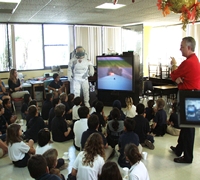
A new partnership will expand the availability of closed captioning (CC) and audio description (AD) in multimedia educational content–giving students who are hearing or visually impaired, are English language learners, or have other challenges greater access to digital learning opportunities.
The U.S. Department of Education (ED) has awarded two 5-year grants to CaptionMax for a collaboration with Discovery Education, intended to increase the accessibility of educational media used in K-12 classrooms.
Digital content that includes CC uses an on-screen transcription of the audio portion of a program. Deaf and hard-of-hearing students, as well as students with learning disabilities and those learning English, can follow along with classmates and keep pace with the rest of their class using CC. A teacher or student may turn off the captions if these are not needed.
Discovery Education’s streaming video collection currently offers more than 1,700 full-length programs and 13,000 core-concept video clips with CC. The grant project will increase these numbers.
Many Discovery videos also will be audio described, so that visually impaired students can access program content through a voice-over that describes key visual elements. The AD feature is mixed into the original program audio. Besides benefiting visually impaired students, AD can help students who learn best aurally or through multi-sensory input, CaptionMax says.
Through the partnership, CaptionMax will add CC and AD features to Discovery Education streaming videos in batches.
Dale Fulton, Discovery Education’s senior vice president of curriculum development, estimated that in the first 80 hours of work, approximately 150 to 200 new videos will be equipped with both CC and AD features.
Updated videos are available to educators as soon as they are loaded into the streaming service. Educators are alerted to new streaming content via a monthly newsletter.
“What is really unique about this [partnership] is that it is opening up the world to more students,” Fulton said. “It’s a remarkable way to differentiate instruction.”
Help for students with visual or aural impairments is frequently lacking in classrooms.
“This is a great step forward. The closed captioning is often missing in classrooms,” said Tracy Gray, director of the National Center for Technology Innovation (NCTI) and a managing research scientist at the American Institutes of Research. NCTI advocates for technology’s role in expanding learning opportunities for individuals with learning disabilities.
Gray praised the partnership and its members for their efforts.
Educators say visually impaired students often have trouble keeping up with classroom videos.
“Visually impaired students often find themselves in a classroom where the teacher is showing a video to complement the lesson and are left with no access to the messages that are provided on the screen,” said Jill Soule, a high school teacher in San Diego, Calif.
“The few times my students have experienced video description, they have been ecstatic. The insight these descriptions afforded them was unlike anything they had experienced before.”
And expanding the accessibility of classroom videos to visually and hearing impaired students helps educators use digital content in the most effective way possible.
“Digital content, such as video, is proven to be a valuable resource in the classroom, engaging students through both the visual and aural senses,” said Kelli Campbell, senior vice president of content and product development for Discovery Education.
“Expanding the availability of titles with captioning and audio description increases the ways educators can integrate digital content into existing curriculum.”
Links:
- Friday 5: College and career readiness - April 12, 2024
- Cybersecurity: eSN Innovation Roundtable - April 11, 2024
- School-home communication remains a challenge for many districts - April 10, 2024
